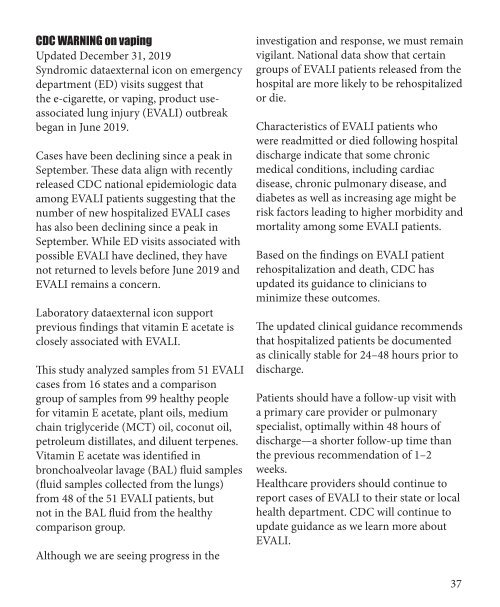JAN 8-14 THE ULTIMATE QUEER GUIDE THIS WEEK
DDG's first pick is now Andrew Yang! (News flash I will vote blue no matter who) He is the only one that gets this brave new world. LOCAL Bars | Lodging | Restaurants | Events | Classifieds | Business Listings | Massage | Maps
DDG's first pick is now Andrew Yang! (News flash I will vote blue no matter who) He is the only one that gets this brave new world. LOCAL Bars | Lodging | Restaurants | Events | Classifieds | Business Listings | Massage | Maps
Create successful ePaper yourself
Turn your PDF publications into a flip-book with our unique Google optimized e-Paper software.
CDC WARNING on vaping<br />
Updated December 31, 2019<br />
Syndromic dataexternal icon on emergency<br />
department (ED) visits suggest that<br />
the e-cigarette, or vaping, product useassociated<br />
lung injury (EVALI) outbreak<br />
began in June 2019.<br />
Cases have been declining since a peak in<br />
September. These data align with recently<br />
released CDC national epidemiologic data<br />
among EVALI patients suggesting that the<br />
number of new hospitalized EVALI cases<br />
has also been declining since a peak in<br />
September. While ED visits associated with<br />
possible EVALI have declined, they have<br />
not returned to levels before June 2019 and<br />
EVALI remains a concern.<br />
Laboratory dataexternal icon support<br />
previous findings that vitamin E acetate is<br />
closely associated with EVALI.<br />
This study analyzed samples from 51 EVALI<br />
cases from 16 states and a comparison<br />
group of samples from 99 healthy people<br />
for vitamin E acetate, plant oils, medium<br />
chain triglyceride (MCT) oil, coconut oil,<br />
petroleum distillates, and diluent terpenes.<br />
Vitamin E acetate was identified in<br />
bronchoalveolar lavage (BAL) fluid samples<br />
(fluid samples collected from the lungs)<br />
from 48 of the 51 EVALI patients, but<br />
not in the BAL fluid from the healthy<br />
comparison group.<br />
Although we are seeing progress in the<br />
investigation and response, we must remain<br />
vigilant. National data show that certain<br />
groups of EVALI patients released from the<br />
hospital are more likely to be rehospitalized<br />
or die.<br />
Characteristics of EVALI patients who<br />
were readmitted or died following hospital<br />
discharge indicate that some chronic<br />
medical conditions, including cardiac<br />
disease, chronic pulmonary disease, and<br />
diabetes as well as increasing age might be<br />
risk factors leading to higher morbidity and<br />
mortality among some EVALI patients.<br />
Based on the findings on EVALI patient<br />
rehospitalization and death, CDC has<br />
updated its guidance to clinicians to<br />
minimize these outcomes.<br />
The updated clinical guidance recommends<br />
that hospitalized patients be documented<br />
as clinically stable for 24–48 hours prior to<br />
discharge.<br />
Patients should have a follow-up visit with<br />
a primary care provider or pulmonary<br />
specialist, optimally within 48 hours of<br />
discharge—a shorter follow-up time than<br />
the previous recommendation of 1–2<br />
weeks.<br />
Healthcare providers should continue to<br />
report cases of EVALI to their state or local<br />
health department. CDC will continue to<br />
update guidance as we learn more about<br />
EVALI.<br />
37


















